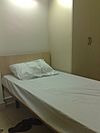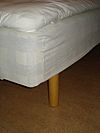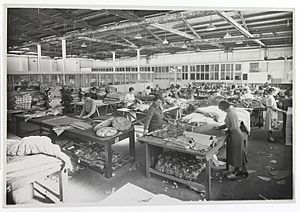Bedding facts for kids
Bedding (also called bedclothes or bed linen) includes all the soft things you put on your bed. This means items like bed sheets, blankets, and pillows. Bedding helps keep your bed clean, warm, and comfy. It also protects your mattress. You can easily take bedding off to wash it. Many people have a few sets of bedding. They change them often, especially when the weather changes, to stay comfortable.
In America, "bedding" usually does not include the mattress itself. But in Britain, it often does. In Australia and New Zealand, bedding is sometimes called manchester. This name comes from Manchester, England. It was a big center for making cotton goods like sheets and towels a long time ago.
A basic set of bedding usually has a bed sheet that fits over the mattress. It also has a flat top sheet. Then, you add a blanket, a quilt, or a duvet. Sometimes, a duvet cover is used instead of a top sheet. You also need pillows with pillowcases. People often add more blankets if their room is cold. Kids and some adults also like to decorate their beds with stuffed animals. These toys are not bedding, but they can add extra warmth!
Contents
What is Bedding Made From?
Most bedding is made from lightweight cotton or cotton-polyester mixes. These fabrics can be plain, shiny (satin), or soft and fuzzy (flannel). Sometimes, bedding is also made from linen or silk.
For warm and light fillings in duvets and quilts, people often use down from geese or ducks. However, tiny feathers can sometimes poke out. This can bother people, especially those with allergies. So, many companies now make fillings from natural or man-made materials that are like down but don't cause allergies.
Other common fillings include cotton, wool, or polyester. These are often used in quilts and comforters. They are usually cheaper and easier to wash than real down. Blankets are often made from thick wool, cotton, or soft synthetic fibers.
A Brief History of Bedding
People have used bedding for thousands of years!
Ancient Beds and Bedding
Around 3400 BC, ancient Egyptian pharaohs started sleeping on beds raised off the ground. Bed linen was very important in Egypt. It showed light, purity, and wealth. Egyptian mummies were even wrapped in bed linen.
In the Roman Empire, mattresses were filled with wool, feathers, or hay. Their beds were fancy, decorated with paint, bronze, silver, jewels, and gold. It was rare for Roman couples to sleep in the same room. They often had separate rooms.
Bedding in the Renaissance and Beyond
During the Renaissance period (about 1300-1600s), mattresses were stuffed with straw and feathers. They were covered with fancy silks, velvets, or satin. Beds became very expensive with embroidered canopies and featherbeds. They were often passed down through families.
In the 1700s, Europeans started using bed frames made of cast iron. Mattresses began to be made of cotton. Before this, it was normal for even royal beds to have bugs!
The box spring was invented in the 1800s. This made beds much more comfortable. In the 1900s, people in the United States started using inner spring mattresses. Later, in the 1960s, water beds became popular. People also started using Japanese-style futons, air mattresses, and foam mattresses and pillows.
Common Bedding Items
Here are some common items you might find on a bed:
| Name | Image | What it is |
|---|---|---|
| Bed skirt (or dust ruffle) | A decorative piece that covers the space under your bed. It hides the box spring and bed legs. | |
| Bedspread (or bedcover) |  |
A large, often decorative, cover that goes over all your bedding. It reaches to or near the floor. It protects your bedding from dust during the day. |
| Blanket | A woven cloth covering used to keep you warm. | |
| Bolster |  |
A long, narrow, round pillow. It's used for decoration or to support your back when you lean against the headboard. |
| Comforter |  |
A bed cover filled with soft material. It's used like a blanket. Comforters are usually reversible and can be washed in a machine. |
| Coverlet |  |
A type of bedspread popular before the 1900s. It usually doesn't reach the floor or cover the pillows. |
| Duvet |  |
A soft, flat bag filled with down feathers or synthetic materials. It's used like a blanket. It's often thicker than a comforter. |
| Duvet cover |  |
A decorative cover for a duvet. It protects the duvet and can be easily washed. Most have buttons or ties to close them. |
| European pillow (or Continental pillow) |  |
A large square pillow. It's often used for decoration, placed behind your regular pillows against the headboard. |
| Feather bed | A soft layer filled with feathers that sits on top of your mattress. It makes the mattress feel softer. | |
| Flat sheet (or top sheet) | A flat sheet that goes over your fitted sheet. It's usually tucked in at the sides and foot of the bed. | |
| Fitted sheet |  |
This is the bottom sheet that fits tightly over your mattress. It has elastic corners to stay in place. |
| Mattress pad (or mattress topper) | This goes on top of the mattress, under the fitted sheet. It adds comfort or protects the mattress. | |
| Mattress protector |  |
This goes directly on top of the mattress to protect it. Some also help protect you from allergens. |
| Pillow shams |  |
Decorative covers for pillows. They often have ruffles or special designs. You usually place them behind your sleeping pillows. |
| Quilt |  |
A type of blanket made by stitching together two layers of cloth with a filling in between. Patchwork quilts are made from many small pieces of fabric sewn together. |
| Sleeping pillow |  |
The regular rectangular pillow you rest your head on when you sleep. They come in different sizes and firmness levels. |
| Throw pillow |  |
A small, decorative pillow that comes in many shapes and sizes. |
Bedding Terms to Know
- Drop: How far a bed skirt hangs down.
- Flanged: A decorative edge on pillows or pillow shams.
- Hotel bedding: Sheets that feel luxurious, like those in a fancy hotel. They often have a high thread count.
- Mako cotton: A very high-quality cotton from Egypt. It has long fibers, making threads stronger and finer. This creates soft, strong, and breathable fabrics.
- Pima cotton: Another high-quality cotton, similar to Mako cotton. It's known for its softness, shine, and durability. Peru produces most of the world's Pima cotton.
- Pleated: Fabric that is folded and sewn, like an accordion.
- Tailored: Made to fit very precisely.
- Thread count: The number of threads woven into one square inch of fabric. A higher thread count often means a softer fabric.
- Throw blanket (or throw): A small blanket often used for warmth and decoration. It's usually placed at the end of the bed.
Bedding Sizes
Bedding sizes are made to fit different bed sizes and mattresses. Bed sizes can be different around the world, so bedding also comes in many different standard sizes.
See also
 In Spanish: Ropa de cama para niños
In Spanish: Ropa de cama para niños



